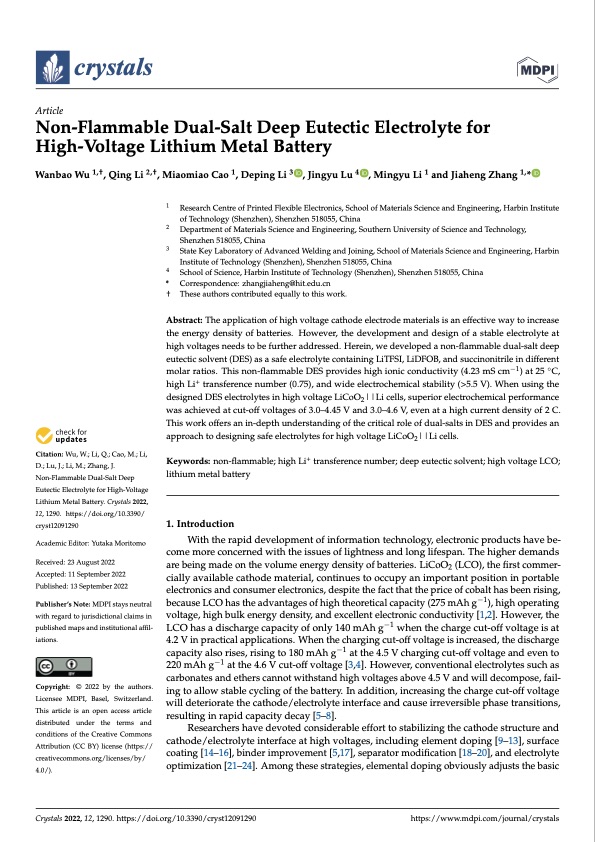
PDF Publication Title:
Text from PDF Page: 001
crystals Article Non-Flammable Dual-Salt Deep Eutectic Electrolyte for High-Voltage Lithium Metal Battery Wanbao Wu 1,†, Qing Li 2,†, Miaomiao Cao 1, Deping Li 3 , Jingyu Lu 4 , Mingyu Li 1 and Jiaheng Zhang 1,* 1 2 3 4 * Correspondence: zhangjiaheng@hit.edu.cn † These authors contributed equally to this work. Abstract: The application of high voltage cathode electrode materials is an effective way to increase the energy density of batteries. However, the development and design of a stable electrolyte at high voltages needs to be further addressed. Herein, we developed a non-flammable dual-salt deep eutectic solvent (DES) as a safe electrolyte containing LiTFSI, LiDFOB, and succinonitrile in different molar ratios. This non-flammable DES provides high ionic conductivity (4.23 mS cm−1) at 25 ◦C, high Li+ transference number (0.75), and wide electrochemical stability (>5.5 V). When using the designed DES electrolytes in high voltage LiCoO2||Li cells, superior electrochemical performance was achieved at cut-off voltages of 3.0–4.45 V and 3.0–4.6 V, even at a high current density of 2 C. This work offers an in-depth understanding of the critical role of dual-salts in DES and provides an approach to designing safe electrolytes for high voltage LiCoO2||Li cells. Keywords: non-flammable; high Li+ transference number; deep eutectic solvent; high voltage LCO; lithium metal battery 1. Introduction With the rapid development of information technology, electronic products have be- come more concerned with the issues of lightness and long lifespan. The higher demands are being made on the volume energy density of batteries. LiCoO2 (LCO), the first commer- cially available cathode material, continues to occupy an important position in portable electronics and consumer electronics, despite the fact that the price of cobalt has been rising, because LCO has the advantages of high theoretical capacity (275 mAh g−1), high operating voltage, high bulk energy density, and excellent electronic conductivity [1,2]. However, the LCO has a discharge capacity of only 140 mAh g−1 when the charge cut-off voltage is at 4.2 V in practical applications. When the charging cut-off voltage is increased, the discharge capacity also rises, rising to 180 mAh g−1 at the 4.5 V charging cut-off voltage and even to 220 mAh g−1 at the 4.6 V cut-off voltage [3,4]. However, conventional electrolytes such as carbonates and ethers cannot withstand high voltages above 4.5 V and will decompose, fail- ing to allow stable cycling of the battery. In addition, increasing the charge cut-off voltage will deteriorate the cathode/electrolyte interface and cause irreversible phase transitions, resulting in rapid capacity decay [5–8]. Researchers have devoted considerable effort to stabilizing the cathode structure and cathode/electrolyte interface at high voltages, including element doping [9–13], surface coating [14–16], binder improvement [5,17], separator modification [18–20], and electrolyte optimization [21–24]. Among these strategies, elemental doping obviously adjusts the basic Research Centre of Printed Flexible Electronics, School of Materials Science and Engineering, Harbin Institute of Technology (Shenzhen), Shenzhen 518055, China Department of Materials Science and Engineering, Southern University of Science and Technology, Shenzhen 518055, China State Key Laboratory of Advanced Welding and Joining, School of Materials Science and Engineering, Harbin Institute of Technology (Shenzhen), Shenzhen 518055, China School of Science, Harbin Institute of Technology (Shenzhen), Shenzhen 518055, China Citation: Wu, W.; Li, Q.; Cao, M.; Li, D.; Lu, J.; Li, M.; Zhang, J. Non-Flammable Dual-Salt Deep Eutectic Electrolyte for High-Voltage Lithium Metal Battery. Crystals 2022, 12,1290. https://doi.org/10.3390/ cryst12091290 Academic Editor: Yutaka Moritomo Received: 23 August 2022 Accepted: 11 September 2022 Published: 13 September 2022 Publisher’s Note: MDPI stays neutral with regard to jurisdictional claims in published maps and institutional affil- iations. Copyright: © 2022 by the authors. Licensee MDPI, Basel, Switzerland. This article is an open access article distributed under the terms and conditions of the Creative Commons Attribution (CC BY) license (https:// creativecommons.org/licenses/by/ 4.0/). Crystals 2022, 12, 1290. https://doi.org/10.3390/cryst12091290 https://www.mdpi.com/journal/crystalsPDF Image | Non-Flammable Dual-Salt Deep Eutectic Electrolyte

PDF Search Title:
Non-Flammable Dual-Salt Deep Eutectic ElectrolyteOriginal File Name Searched:
crystals-12-01290-v2.pdfDIY PDF Search: Google It | Yahoo | Bing
Product and Development Focus for Salgenx
Redox Flow Battery Technology: With the advent of the new USA tax credits for producing and selling batteries ($35/kW) we are focussing on a simple flow battery using shipping containers as the modular electrolyte storage units with tax credits up to $140,000 per system. Our main focus is on the salt battery. This battery can be used for both thermal and electrical storage applications. We call it the Cogeneration Battery or Cogen Battery. One project is converting salt (brine) based water conditioners to simultaneously produce power. In addition, there are many opportunities to extract Lithium from brine (salt lakes, groundwater, and producer water).Salt water or brine are huge sources for lithium. Most of the worlds lithium is acquired from a brine source. It's even in seawater in a low concentration. Brine is also a byproduct of huge powerplants, which can now use that as an electrolyte and a huge flow battery (which allows storage at the source).We welcome any business and equipment inquiries, as well as licensing our flow battery manufacturing.| CONTACT TEL: 608-238-6001 Email: greg@salgenx.com | RSS | AMP |